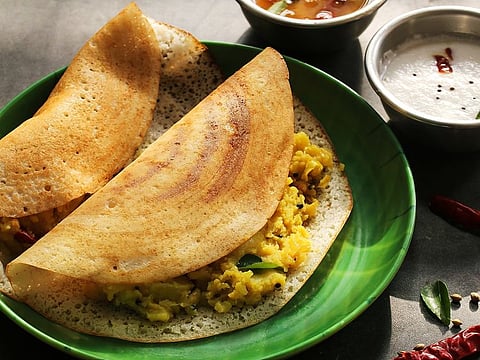Crispy masala dosa: An Indian breakfast dish with mysterious origins
Is it from Tamil Nadu or Karnataka? The rice-lentil-based dish has many tales behind it…

Sundays in Chennai, the capital city of Tamil Nadu in India, are different. At 6am, you would find tiny little eateries opening up after washing the entrance and illustrating a small pattern on the doorstep, which residents call kolam.
By 7am, the aroma from strong brews of filter coffee would fill the air; followed by the first splutter of mustard seeds mixed with curry leaves; golden-brown and crispy medu vadas, a fritter made with black lentils, spices and curry leaves, taken out of the oil and placed on a greased banana leaf; and the sight of a shiny, conical dosa, luring every resident to sit inside the restaurant and eat. This was the perfect way to start the last day of the weekend.
The dosa is a staple to the southern state, no matter the day. The batter is made by soaking rice and black gram overnight, which is then ground to a paste and left to ferment, after which it is poured on an iron griddle. The rice crepes are often served with a side of coconut, tomato, coriander chutneys along with sambar, and has a special place for many across the world.
Today, there are several types of dosas; however, its most popular version still remains the humble masala dosa – a dosa or rice crepe with a spiced potato filling. The filling uses boiled potatoes, mustard seeds, grated coconut, turmeric powder, coriander leaves, and lemon juice.
However, the dish doesn’t originate from Tamil Nadu but from Udupi in Karnataka….
The many tales of masala dosa
Legend has it that dosa was an invention of a Brahmin adiga (cook), who decided to rebel against his community and its beliefs. Brahmins weren’t allowed to consume anything fermented at the time, so he decided to go against that and create something of his own using fermented rice. Although he failed, he decided to cook with it instead and poured a spoonful of batter on an iron griddle and spread the batter in a circular motion using a ladle. When cooked, it became a thin, crispy, crepe-like pancake, but savoury. Since this cook had indulged in dosha – the term used to describe evil – the dish was titled the same, which later turned to dosa or dosai.
However, the addition of masala came much later on. It is said that the dosa was initially served with a plain potato gravy. The Brahmins were in charge of all the cooking in south India. They were against the addition of onions in their dishes. However, when they ran out of potatoes, they would chop up a few onions and add them to the gravy. This gravy would be simmered until the water evaporated and would be used as a filling for the rice crepe, which would be served with a different fold – the right flap would be over the left flap – giving the impression of a cylinder.
Another tale narrates that it was one of the kings of Mysore, Someshvara III, who was the inventor of the masala dosa. The king had hosted an extravagant party that served a lot of food to his guests. However, once the party had come to an end, the king noticed that there were a lot of food left behind. Since he didn’t want the food to go to waste, he called in his team of cooks to come up with something creative. The cooks set out to work by combining leftover potatoes with spices and then used as a filling for the plain dosa. However, the cooks would add a layer of spicy red chutney beneath the spiced potatoes and then fold the crepe and serve it with a side of plain coconut chutney.
A popular and full meal
No matter the origin story, masala dosa continues to be popular all over India. However, the north was introduced to the dish by Madras Hotel (present-day Madras Coffee House) in Connaught Place, New Delhi. While it was forgotten as new dishes came up, a small restaurant owner named K Krishna Rao reintroduced the dish with a modern-day recipe. He sold it exclusively under his brand Woodlands, when he expanded his restaurant’s branch from Udupi to Mumbai, post-independence in 1947.
Has this story got you craving a plate of Masala Dosa? Try out the recipe here!
Share your food stories and recipes with us on food@gulfnews.com
Sign up for the Daily Briefing
Get the latest news and updates straight to your inbox




